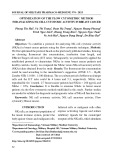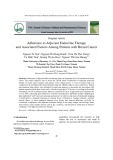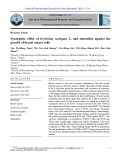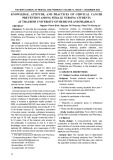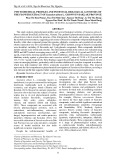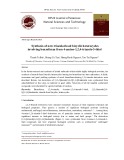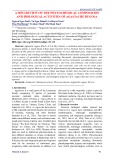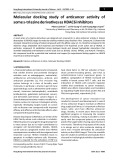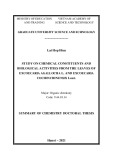doi:10.1111/j.1432-1033.2004.04249.x
Eur. J. Biochem. 271, 3171–3179 (2004) (cid:1) FEBS 2004
Presence of membrane ecdysone receptor in the anterior silk gland of the silkworm Bombyxmori
Mohamed Elmogy, Masafumi Iwami and Sho Sakurai
Division of Life Sciences, Graduate School of Natural Science and Technology, Kanazawa University, Kakumamachi, Japan
X-114 showed that the binding sites might be integrated membrane proteins. These results indicated that the binding sites are located in plasma membrane proteins, which we putatively referred to as membrane ecdysone recep- tor (mEcR). The mEcR exhibited saturable binding for [3H]PonA (Kd ¼ 17.3 nM, Bmax ¼ 0.82 pmolÆmg)1 pro- tein). Association and dissociation kinetics revealed that [3H]PonA associated with and dissociated from mEcR within minutes. The combined results support the existence of a plasmalemmal ecdysteroid receptor, which may act in concert with the conventional EcR in various 20E-depend- ent developmental events.
Keywords: ecdysone agonist; ecdysone receptor; kinetics; nongenomic; ponasterone A. Nongenomic action of an insect steroid hormone, 20-hy- droxyecdysone (20E), has been implicated in several 20E- dependent events including the programmed cell death of Bombyx anterior silk glands (ASGs), but no information is available for the mode of the action. We provide evidence for a putative membrane receptor located in the plasma mem- brane of the ASGs. Membrane fractions prepared from the ASGs exhibit high binding activity to [3H]ponasterone A (PonA). The membrane fractions did not contain conven- tional ecdysone receptor as revealed by Western blot analysis using antibody raised against Bombyx ecdysone receptor A (EcR-A). The binding activity was not solubilized with 1 M NaCl or 0.05% (w/v) MEGA-8, indicating that the binding sites were localized in the membrane. Differential solubili- zation and temperature-induced phase separation in Triton
serve as receptors that
Steroids elicit various physiological responses, particularly those involving the genomic aspects of action, in which they modulate gene transcription by interacting with intracellular nuclear ligand- dependent transcription factors [1]. In addition to the genomic steroid actions, increasing evidence of rapid, nongenomic steroid effects has been demonstrated for virtually all groups of steroids [2].
activity of target genes [6]. In addition, a nongenomic action of 20E has been supposed for decades. 20E increases the cellular cAMP level in the prothoracic glands of Manduca sexta [7] and in the fat body of Mamestra brassicae [8]. 20E rapidly reduces the excitatory potentials at neuromuscular junctions in amplitude within minutes in both the crayfish [9] and Drosophila [10]. These responses to 20E fail to fit the classical genomic model, and appear instead to rely on mechanisms involving membrane receptors and second messengers. Nevertheless, the presence of membrane recep- tors remains speculative.
Correspondence to S. Sakurai, Division of Biological Science, Graduate School of Natural Science and Technology, Kanazawa University, Kakumamachi, Kanazawa 920-1192, Japan. Fax: +76 2646250, Tel.: + 76 2646255, E-mail: ssakurai@kenroku.kanazawa-u.ac.jp Abbreviations: ASG, anterior silk gland; 20E, 20-hydroxyecdysone; EcR, ecdysone receptor; mEcR, membrane ecdysone receptor; PCD, programmed cell death; PonA, ponasterone A (25-deoxy- 20-hydroxyecdysone); USP, ultraspiracle; ECL, enhanced chemoluminescence detection. (Received 19 April 2004, revised 3 June 2004, accepted 8 June 2004)
Ecdysone, an insect steroid hormone synthesized by prothoracic glands, is essential for inducing the molecular and cellular events that lead to molting and metamorphosis in insects and crustaceans [3–5]. 20-Hydroxyecdysone (20E), the biologically active form of ecdysone, binds to a functional nuclear ecdysone receptor consisting of an ecdysone receptor (EcR) and its heterodimeric partner, ultraspiracle (USP), and thereby controls the transcriptional
20E is the primary factor inducing programmed cell death (PCD) of larval tissues at pupal metamorphosis [11–13]. The anterior silk gland (ASG) is a larval-specific tissue, which is destined to die shortly after pupation, and enters the process of PCD in response to the high hemolymph ecdysteroid concentration that induces pupal metamorphosis [14]. In the PCD of ASGs induced by 20E in vitro, the gene expression required for completion of PCD is accomplished during the first 8 h of 20E challenge, but withdrawal of 20E before 30 h of the culture interferes with the PCD sequence [14]. If the genomic theory of steroid action is applicable to 20E- induced PCD, 20E challenge for 8 h should be sufficient for execution of PCD. This implies that the effects of 20E during the period between 8 and 30 h are not accompanied by gene expression but rather are mediated by a non- genomic pathway, probably through a membrane-bound receptor. If this is the case, ASG plasma membranes may contain high-affinity binding sites for ecdysteroid. The present study reports for the first time the presence of such sites in the membranes of insect cells and the biochemical
3172 M. Elmogy et al. (Eur. J. Biochem. 271)
(cid:1) FEBS 2004
Preparation of nuclear extracts characterization of the putative membrane ecdysteroid receptor.
Materials and methods
Animals and ASGs
Silkworm, Bombyx mori (Kinshu · Showa F1 hybrid), were reared on an artificial diet (Silkmate, Nihon-Nosan- Kogyo, Yokohama, Japan) at 25 (cid:2)C under 12-h light/12-h dark cycle [15]. ASGs were dissected on the day of gut purge [14] and cultured separately in 0.3 mL Grace’s insect culture medium (Gibco BRL) at 25 (cid:2)C for 18 h with 20E followed by a culture in a hormone-free medium for a further 12 h [14]. Because preliminary experiments showed that the binding activity in the membrane fractions prepared from the cultured ASGs was higher than that from the freshly dissected ASGs, we mainly used such ASGs unless mentioned otherwise.
Chemicals
Nuclear extract was mainly prepared according to Wu [17] with a minor modification. Briefly, dissected ASGs were washed once in 100 mM phosphate buffer pH 7.9 with 100 mM NaCl and homogenized on ice with two vols 10 mM Hepes pH 7.9 with 10 mM KCl, 0.3 M sucrose, 1.5 mM MgCl2, 0.1 mM EDTA, 0.5 mM 2-mercaptoethanol and protease inhibitors cocktail (Complete; Roche Diagno- sis), by 12 strokes in a Dounce tissue grinder (1 mL; Wheaton, Millville, NJ, USA). The suspension was centri- fuged for 8 min at 1600 g at 4 (cid:2)C. The resulting pellet was resuspended in two vols 10 mM Hepes pH 7.9 containing 0.4 M NaCl, 5% (v/v) glycerol, 1.5 mM MgCl2, 0.1 mM EDTA, 0.5 mM dithiothreitol and 0.5 mM phenyl- methanesulfonyl fluoride, and 5 M NaCl was added to yield a final concentration of 0.4 M NaCl. The suspension was incubated at 4 (cid:2)C under gentle shaking for 30 min and subsequently centrifuged at 2 (cid:2)C at 105 000 g for 60 min. The resulting supernatant was dialysed for 4 h using a dialysis tube with 14 000 Da cut-off size (Wako Pure Chemical Industries) against 1000 vols 20 mM Hepes pH 7.9 containing 20 mM NaCl, 20% (v/v) glycerol, 1 mM EDTA and 0.5 mM 2-mercaptoethanol and the protease inhibitor cocktail. The buffer was changed once after 2 h dialysis time. The sample was clarified by 10 min centrifugation at 10 000 g at 4 (cid:2)C, and the supernatant was supplemented with the protease inhibitors.
SDS/PAGE and Western blot analysis
Ponasterone A (PonA, 25-deoxy-20-hydroxyecdysone) and 20E were from Sigma and nonsteroid ecdysone agonists [methoxyfenozide (RH-2485), tebufenozide (RH-5992), RH-5849] were gifts from Y. Nakagawa, Kyoto University, Japan. Ecdysteroids and the agonists were dissolved in ethanol and stored at )20 (cid:2)C until use. [3H]PonA (200 CiÆmmol)1) and [14C]methoxyinulin (2.4 mCiÆmmol)1) were from PerkinElmer Life Sciences. Triton X-114 and butylatedhydroxytoluene were from Sigma. To remove any Triton X-114-insoluble materials, Triton X-114 (10 mL) was added with 8 mg of butylatedhydroxytoluene and 190 mL 20 mM potassium phosphate buffer pH 7.5 con- taining 0.15 M KCl [16]. The mixture was cooled to near 0 (cid:2)C, centrifuged at 3000 g for 10 min to remove any insoluble material, and then the condensed detergent was incubated for 20 h at 35 (cid:2)C. The purified detergent (lower phase) was stored at room temperature.
Preparation of membrane fraction
SDS/PAGE was performed according to Laemmli [18] using 12% polyacrylamide gel. The samples in reducing loading buffer were heated in a boiling water bath for 10 min. The gel was stained with Coomassie brilliant blue. For Western blot analysis, the blotting membrane was agitated in Tris-buffered saline (NaCl/Tris: 25 mM Tris/ HCl, pH 7.4, 3 mM KCl, 136 mM NaCl) containing 5% (w/v) nonfat milk for 2 h and then incubated with a rabbit antibody raised against the EcR-A-specific region of EcR (a gift from H. Fujiwara, University of Tokyo) at 4 (cid:2)C overnight. After washing with NaCl/Tris, the membrane was incubated with horseradish peroxidase-conjugated protein A in the fresh NaCl/Tris containing 5% (w/v) nonfat milk at 4 (cid:2)C for 2 h. Visualization of the immuno- blot was carried out using the enhanced chemoluminescence detection (ECL) system according to the manufacturer’s instructions and exposed to Hyperfilm ECL (Amersham Pharmacia Biotech).
Binding assay
Freshly dissected or cultured ASGs were washed three times with insect Ringer’s solution (130 mM NaCl, 4.7 mM KCl, 1.9 mM CaCl2). All subsequent procedures were performed at 4 (cid:2)C. ASGs were homogenized in seven vols binding assay buffer (20 mM Tris/HCl pH 7.0, 2 mM EDTA, 1 mM phenylmethylsulphonyl fluoride, 3 lgÆmL)1 pepstatin A, 3 lgÆmL)1 leupeptin) using a motor-driven, loose-fitting glass-plastic homogenizer at 1000 r.p.m. for 1 min. After centrifugation at 1000 g for 10 min, the pellet was suspen- ded in the buffer and centrifuged at 1500 g for 10 min. The pellet was again suspended in the buffer and centrifuged at 1800 g for 10 min. The resulting pellet was resuspended in the buffer, homogenized again using HG30 homogenizer (Hitachi) on ice, and centrifuged at 1000 g for 10 min. The supernatant was centrifuged at 8000 g for 10 min, and the resulting supernatant was centrifuged at 105 000 g for 5 h. The pellet was suspended in the buffer, frozen with liquid nitrogen, and stored at )80 (cid:2)C until use. Protein amounts were measured using a DC protein assay kit (Bio-Rad) with BSA as standard. Specific binding of PonA was assayed by an ultracentri- fugation method [19] adapted to the measurement of ecdysteroid membrane receptors. Membrane fractions (100 lL reaction mixture containing 100 lg protein) were incubated with [3H]PonA in 0.5 lL of the buffer solution containing 0.05 lCiÆlL)1 [14C]methoxyinulin. [14C]Meth- oxyinulin was added to estimate the degree of contaminated [3H]PonA in the precipitate after centrifugation, that originated from the incubation medium. The mixture was incubated at 25 (cid:2)C for 10 min unless mentioned otherwise.
Membrane ecdysone receptor (Eur. J. Biochem. 271) 3173
(cid:1) FEBS 2004
After incubation, the mixture was centrifuged at 100 000 g for 15 min at 2 (cid:2)C. The supernatant was discarded and the insides of the tubes were rinsed with 100 lL of the buffer. Radioactivity in the pellet was measured using a Beckman LS-700 counter with a dual-label program (Beckman- Coulter). Saturation analysis was performed to determine receptor number per mg protein and binding affinity to PonA. Membrane fractions were equilibrated with increas- ing concentrations of [3H]PonA in the absence or presence of a 1000-fold excess of unlabelled PonA. For association kinetics, membrane fractions were incubated with 25 nM [3H]PonA (± excess unlabelled PonA) for periods of time ranging from 1 to 40 min. Dissociation kinetics were determined by equilibrating membrane fractions with 25 nM [3H]PonA for 10 min followed by the addition of 25 lM unlabelled PonA. In the competition assay, mem- brane fractions were incubated with 25 nM [3H]PonA in the presence of increasing concentrations of unlabelled ecdy- steroids and ecdysone agonists. A modified dextran-coated active charcoal method [19] was used for phase partitioning samples in Triton X-114. for 1 h followed by centrifugation at 100 000 g for 1 h at 0 (cid:2)C. The detergent insoluble pellet was washed with the buffer and resuspended in the buffer prior to assaying the binding activity. The supernatant was overlaid on a cushion of buffered 6% sucrose, incubated at 30 (cid:2)C for 10 min and centrifuged at 3000 g for 5 min in a swing-rotor. The lower phase was a detergent phase that was directly subjected to the binding assay. The upper aqueous phase was transferred to a tube, and fresh Triton X-114 was added to a final concentration of 0.5% (v/v). After mixing and incubating on ice for 1 h, the mixture was overlaid on the same sucrose cushion, kept at 30 (cid:2)C for 10 min, and centrifuged at 3000 g for 5 min in a swing-rotor. The resulting upper aqueous phase was transferred to a tube to which fresh Triton X-114 with the same starting concentration (0.5–3%) was added. The sample was mixed, kept on ice and then at 30 (cid:2)C for 10 min. After centrifugation at 3000 g for 5 min, the supernatant was used as a final aqueous phase. The three phases (detergent-insoluble pellet, detergent phase and aqueous phase) were assayed for the binding activities, and the activities were expressed as a percentage of the total activity in all three phases.
Topological localization of the binding sites Data analysis
Experimental data were analysed using ORIGIN software (OriginLab, Northampton, MA, USA). Saturation binding curves were fitted and analysed using equations built into TM 3.02 (GraphPad Software, San Diego, GRAPHPAD PRISM CA, USA) according to Swillens [25].
Results
(S1) and pellet Biochemical characterization of [3H]PonA binding
To examine whether PonA binding sites are located in peripheral proteins that are not integrated to the lipid bilayers or integral membrane proteins, topological local- ization study of the binding sites in the membranes was performed according to Kerkhoff et al. [20,21]. The mem- brane suspensions (5 mgÆmL)1 protein) were treated with a solution of high ionic strength (binding assay buffer containing 1 M NaCl) for 60 min at 4 (cid:2)C. The mixtures were centrifuged at 105 000 g for 60 min at 4 (cid:2)C to obtain (P1). The pellet P1 was supernatant resuspended in the binding assay buffer to a final protein concentration of 20 mgÆmL)1, and an aliquot was stored at )80 (cid:2)C for the binding assay. The remaining suspensions were diluted to 5 mgÆmL)1 protein, treated with 0.05% (v/v) octanoyl-N-methylglycamide (MEGA-8; Wako Pure Chemical Industries) at 4 (cid:2)C for 60 min with constant stirring, and then centrifuged at 105 000 g for 60 min at 4 (cid:2)C. The resulting pellet (P2) was re-suspended in the binding assay buffer to a final protein concentration of 20 mgÆmL)1 and stored at )80 (cid:2)C. The supernatants, S1 and S2, were dialysed against the binding assay buffer overnight at 4 (cid:2)C.
Differential solubilization and temperature-induced phase separation in Triton X-114: three phase system
We first performed biochemical characterization of the binding sites using ASG membrane fractions. The optimal protein concentration for the binding assay was determined using 25 nM [3H]PonA and increasing amounts of proteins in individual incubations. The percentage of specific binding increased in a protein concentration-dependent manner within the range of 25–150 lgÆmL)1 (Fig. 1A). Because the specific binding at 100 lgÆmL)1 protein was approximately 60% of the maximum value at 200 lgÆmL)1, the protein concentration of 100 lgÆmL)1 was used in the following binding assays. The optimum pH was 7.0 at 25 (cid:2)C (Fig. 1B). The binding was temperature dependent, with optimum binding at 37 (cid:2)C and no binding at 60 (cid:2)C (Fig. 1C). Because Bombyx larvae were reared at 25 (cid:2)C in our laboratory, we selected the incubation temperature of 25 (cid:2)C, although the specific binding at 25 (cid:2)C was approxi- mately half of that at 37 (cid:2)C. Based on those results, we used the assay conditions in which 100 lL of binding assay buffer (pH 7.0) containing 100 lg of membrane proteins was incubated at 25 (cid:2)C with 25 nM [3H]PonA, except for the saturation analysis.
Western blot analysis
Integral membrane proteins are classified into two categor- ies, i.e., proteins that covalently attached to the lipid bilayers and those that are anchored in the bilayers [16]. Phase partitioning in Triton X-114 is a quick method to determine which category the mEcR belongs to. The procedure used is a modification of the method of Pryde & Philips [22] and Hooper & Bashir [23]. Triton X-114 was precondensed before use [24]. Purified Triton X-114 solutions with different concentrations (0.5–3%) were added to the ASG membrane fractions (final concentration, 10 mgÆmL)1) in 10 mM phosphate buffer pH 7.4 containing 150 mM KCl, vigorously mixed immediately for 1–2 s, and placed on ice To confirm that the specific binding in the membrane fraction was not brought about by contamination of conventional nuclear EcR, membrane fractions that showed
3174 M. Elmogy et al. (Eur. J. Biochem. 271)
(cid:1) FEBS 2004
Fig. 2. Membrane fractions are free of conventional nuclear EcR. Commassie brilliant blue-stained SDS/PAGE (12% acrylamide gel) (A) and Western blotting for the identical gel using anti-EcR-A serum (1 : 100) as a primary antibody and horseradish peroxidase-conju- gated protein A (1 : 1000) as a secondary antibody (B). Lanes 1, total lysate; lane 2, membrane fraction; lane 3, nuclear extract. Samples for lane 1–3 were prepared from freshly dissected ASGs. Lane 4, mem- brane fraction prepared from the ASGs that were cultured in the same conditions as those used for binding experiments. Twenty micrograms of protein were used in each lane.
EcR isoforms, EcR-A and EcR-B1, EcR-A isoform is predominantly expressed in the ASGs at pupation in Bombyx [26], and therefore we used anti-EcR-A serum for the Western blotting. As samples containing the EcRs, total lysate and nuclear extract prepared from freshly dissected ASGs were used. In the total lysate and nuclear extract, a single immunoreactive signal band at 57 kDa, an approxi- mate molecular mass of Bombyx EcRs, was found (Fig. 2B). By contrast, no immunoreactive signals were found in the membrane fractions of either the freshly dissected ASGs or the ASGs cultured with 20E for 30 h. These results indicated that the specific binding activity in the membrane fractions was not caused by contamination of nuclear receptors.
Fig. 1. Binding of [3H]PonA to membrane fractions of ASGs. (A) Protein amount-dependence of specific [3H]PonA binding. The mem- brane fractions (100 lL) with different protein concentrations were incubated for 10 min at 25 (cid:2)C with 25 nM [3H]PonA without or with a 1000-fold molar excess of inert PonA. Each data point is mean ± SD (n ¼ 3). (B) Optimal pH for [3H]PonA binding. Membrane fractions containing 100 lg protein in 100 lL buffer were incubated with 25 nM [3H]PonA at various pH. Other conditions were the same as for (A). (C) Temperature dependence of [3H]PonA binding. Membrane frac- tions containing 100 lg protein in 100 lL buffer (pH 7) were incu- bated with 25 nM [3H]PonA at various temperatures. j, total binding; d, specific binding; s, nonspecific binding.
Association and dissociation kinetics
specific binding activity to [3H]PonA were subjected to Western blot analysis using an antibody raised against tissues contain two EcR-A (Fig. 2). Although insect The association kinetics of the membrane fractions showed that PonA became associated with the membranes very rapidly as the steady state was attained within 10 min (Fig. 3A). The observed association constant (Kobs) was 0.9 ± 0.2Æmin)1. The dissociation of PonA from its binding sites was measured by adding an excess amount of unlabelled PonA after equilibration with 25 nM [3H]PonA
Membrane ecdysone receptor (Eur. J. Biochem. 271) 3175
(cid:1) FEBS 2004
Fig. 4. PonA saturation analysis of ASG membranes. Membrane preparations (100 lg protein in 100 lL buffer) were incubated with increasing concentrations of [3H]PonA at 25 (cid:2)C for 10 min without or with a 1000-fold excess of unlabelled PonA. The data were fitted by nonlinear regression analysis. Inset is Scatchard analyses of the binding data. Kd ¼ 17.3 nM; Bmax ¼ 0.82 pmolÆmg)1 protein. Each data point is the mean ± SD (n ¼ 3).
showed the presence of a single high-affinity binding site in each molecule, with an apparent Kd and Bmax of 17.3 nM and 0.82 pmolÆmg)1 protein, respectively. This Kd value was in good accordance with the estimated Kd of 17.5 nM derived from the kinetic constants.
M
Fig. 3. Kinetics of association (A) and dissociation (B) of [3H]PonA binding to ASG membranes. Association kinetics: membranes were incubated with 25 nM [3H]PonA for various times without or with a )1Æmin)1. Disso- 1000-fold excess of inert PonA. Kon ¼ 13.3 · 107 ciation kinetics: membranes were incubated with 25 nM [3H]PonA for 10 min at 25 (cid:2)C and then added with a 1000-fold excess of unlabelled PonA to initiate dissociation of [3H]PonA. Inset represents linear regression analysis of the data. Koff ¼ 2.3 ± 0.5 min)1. Each data point is the mean ± SD (n ¼ 3).
M
Topological localization of the binding sites
We examined whether the PonA binding sites are located in integral membrane proteins or peripheral proteins that are not integrated to the lipid bilayers. The membranes were treated with NaCl to examine if the binding sites were located on proteins that simply associate with the lipid bilayers or other scaffold proteins (Fig. 5). After treatment with 1 M NaCl, the binding activity was found only in the P1 fraction, indicating that the proteins responsible for the binding are not peripheral membrane proteins. Then, the P1 fraction was treated with a detergent, MEGA-8, as prelim- inary experiments with eight detergents had shown that only MEGA-8 at low concentration did not solubilize integral membrane proteins but merely fragmented membranes. After treatment with 0.05% MEGA-8, the activity was recovered from P2 fraction and little activity was found in the supernatant. Thus, the binding sites might be on integral membrane proteins.
for 10 min (Fig. 3B). The dissociation of PonA from the membranes occurred within 10 s with a dissociation constant (Koff) of 2.3 ± 0.5 min)1. The calculated associ- )1Æmin)1, and the ation rate constant (Kon) was 13.3 · 107 estimated dissociation constant at equilibrium (Kd) was 17.5 nM. Phase partitioning in the detergent Triton X-114
Saturation analysis
Integral membrane proteins are generally classified into two categories, proteins that are anchored in the lipid bilayers through a transmembrane sequence(s) and those that are covalently attached to the bilayers [16]. To examine the mode of association of the binding sites with the plasma membranes, the membrane fractions were subjected to A saturation analysis of specific binding at 25 (cid:2)C was performed by incubating the membrane fractions with increasing concentrations of [3H]PonA, then subjecting the binding data to Scatchard analysis (Fig. 4). The analysis
3176 M. Elmogy et al. (Eur. J. Biochem. 271)
(cid:1) FEBS 2004
differential solubilization and temperature-induced phase separation in Triton X-114 (Fig. 6). In the absence of detergent the binding activity was found only in the pellet after the first centrifugation step. On increasing the concentration of Triton X-114, the binding activity was recovered predominantly in the detergent-rich phase. The binding in the detergent-insoluble pellet decreased in a complementary manner, and only a low activity was found in the aqueous phase. As the concentration of Triton X-114 was increased from 0.5 to 3%, results were mostly the same as that at 0.5%. These results indicate that the binding sites are neither on a polypeptide(s) that merely associates to the membrane bilayers nor are they covalently associated with the membrane proteins; rather they are on an integral membrane protein(s) that may be anchored in the mem- brane by a transmembrane sequence.
M for PonA and 2.63 · 10)7
Displacement studies
logarithm of
Fig. 5. Topological localization of the binding sites in the ASG mem- branes. The membrane fractions (5 mgÆmL)1) were treated with the binding assay buffer containing 1 M NaCl for 60 min at 4 (cid:2)C and centrifuged at 105 000 g for 60 min at 4 (cid:2)C. The pellet (P1) was resuspended in assay buffer containing 0.05% MEGA-8. After incu- bation for 60 min at 4 (cid:2)C, the mixture was centrifuged at 105 000 g for 60 min at 4 (cid:2)C, and the pellet (P2) was resuspended in the assay buffer. The dialyzed supernatants (S1, S2) and the resuspended pellets (P1, P2) were incubated with 25 nM [3H]PonA under standard assay condi- tions. Binding activity is relative to that in the crude extract (C) with that designated as 100.
Fig. 6. Effects of Triton X-114 concentration on the solubilization and phase separation of ASG membranes. ASG membrane fractions were subjected to differential solubilization and temperature-induced phase separation at the indicated concentrations of Triton X-114. The resulting three phases, detergent-insoluble pellet (j), detergent-rich phase (d) and aqueous phase (s), were assayed for binding activity. Each data point is a mean of duplicate determinations.
Fig. 7. Inhibitory activities of ecdysteroids and ecdysone agonists against the [3H]PonA binding. Membrane fractions (100 lg protein in 100 lL buffer) were incubated for 10 min at 25 (cid:2)C with increasing concentra- tions of unlabelled PonA (d), 20E (s), methoxyfenozide (RH-2485; m), tebufenozide (RH-5992; n) and RH-5849 (h) in the presence of 25 nM [3H]PonA. Each data point is the mean ± SD (n ¼ 3).
the binding activity was Binding affinities of ecdysteroids and nonsteroidal ecdysone agonists to the membrane binding sites were determined by incubating the membrane fractions with 25 nM [3H]PonA in the presence of increasing amounts of unlabelled ecdyster- oids and agonists (Fig. 7). The estimated 50% inhibitory concentration (IC50) for 50% displacement of [3H]PonA was 6.92 · 10)7 M for 20E, showing that the affinity for 20E was approximately 2.6 times higher than that for PonA. The IC50 values for three nonsteroid agonists, RH-5849, tebufenozide (RH-5992) and methoxyfenozide (RH-2485) were much lower than those for PonA and 20E. Comparison of individual values of pIC50, reciprocal the concentration that provides a 50% inhibition of [3H]PonA binding, as well as relative activities to 20-hydroxyecdysone (Table 1) showed that in the order 20E > PonA >> methoxyfenozide > tebufenozide > RH-5849.
Membrane ecdysone receptor (Eur. J. Biochem. 271) 3177
(cid:1) FEBS 2004
Table 1. Binding activities of ecdysteroids and nonsteroidal ecdysone agonists against the membrane binding sites and comparison with the conventional nuclear receptor complex. pCI50(M) reciprocal logarith- mic value of the 50% inhibition. RA activities relative to that of 20-hydroxyecdysone.
mEcR
nEcRa
Compounds
pCI50 (M) RA
pCI50 (M) RA
1 26.4
224 234
6.58 20-Hydroxyecdysone Ponasterone A 6.16 Methoxyfenozide (RH-2485) 5.01 4.86 Tubefenozide (RH-5992) 4.56 RH-5849
6.70 1 8.12 0.38 9.05 0.027 0.019 9.07 0.0096 6.88
1.51
a Binding activities against inherent receptor complex of nuclear EcR (nEcR) and USP from Chilo suppressalis integuments [34].
A second line of evidence to support the existence of a membrane receptor is that the binding affinity of PonA is less than that of 20E. The binding affinity of PonA to the nuclear receptor complex of EcR/USP is one to two orders of magnitude higher than that of 20E [34]. In the inherent receptor complex of the rice stem borer Chilo suppressalis, binding affinity for PonA is 26-fold higher than that for 20E [35], and nuclear extracts of Drosophila Kc-H cells exhibit high binding affinity for PonA with a Kd of 3.4 nM, while Kd for 20E is 240 nM, 70 times lower than that for PonA [36]. Similarly, the affinity of PonA to tick EcR is 28-fold higher than that of 20E [37]. By contrast, the competition assay using the ASG membrane fractions shows that the binding affinity for PonA is one-fourth of that for 20E and that the values for nonsteroidal ecdysone agonists are much lower than 20E, which totally differs from the binding character- istics of the conventional EcR (Table 1).
Discussion
M).
The present study describes for the first time evidence for the presence of a putative receptor for ecdysteroid in tissue membranes and its biochemical characterization in an insect. The membrane receptor exhibits a specific and saturable binding for [3H]PonA with a Kd of 17.3 · 10)9 M. This value is physiologically relevant to the prevailing hemolymph concentrations of 20E (ranging between 10)7 and 10)6 M) in the prepupal period when PCD is triggered in vivo [14]. The association and dissociation kinetics indicated that PonA association with and dissociation from its binding sites were rapid, which is characteristic of the binding of several natural compounds to their membrane receptors [27,28]. The saturation curve indicates the pres- ence of a single high-affinity binding site and an apparent maximal number of binding sites of 0.82 pmolÆmg)1 protein. The obtained Kd value is supported by the good accordance with the estimated dissociation rate constant at equilibrium (Kd ¼ 17.5 · 10)9
Finally, the topological studies indicated the presence of mEcR. The effects of solutions of high ionic strength and detergents have been used to establish the topological localization of several microsomal enzymes involved in phospholipid and triglyceride metabolism [20]. Using a similar approach, the present study revealed a distinct binding activity in the membrane. The differential solubi- lization and temperature-induced phase separation in Tri- ton X-114 (three phase system) gave additional evidence for the presence of mEcR. The particular advantage of Triton X-114 is that its micelles aggregate on warming from 0 (cid:2)C, into a second phase when eventually separating out temperature is raised above 20 (cid:2)C (the so called cloud point). Therefore, integral membrane proteins solubilized at 0–4 (cid:2)C tend to be partitioned preferentially into the detergent-rich phase at the cloud point [16]. When the porcine kidney microvillar membranes are subjected to the three phase system, the ectoenzymes with a covalently attached glycosyl-phosphatidyinositol membrane anchor are recovered in the detergent insoluble pellet, while those anchored by transmembrane spanning polypeptide are recovered in the detergent-rich phase [23]. Similarly, the majority of the integral membrane proteins in adrenal chromaffin granules migrate into a detergent-rich phase, and an aqueous phase contains the insoluble, hydrophilic proteins [22]. We found most of the binding activities for [3H]PonA in the detergent-rich phase, indicating that the mEcR is an integral membrane protein which might be anchored in the membrane by transmembrane sequence of hydrophobic amino acids.
Rapid effects of steroids are triggered by the intracellular signalling cascade, in which membrane-binding sites for some steroids have been linked to the conventional nuclear receptors. In the nongenomic action of estrogen, estrogen receptor a couples with the regulatory subunit of the lipid kinase PI3K to trigger the rapid effects of estradiol [29]. The nongenomic action of progesterone is also mediated by the conventional progesterone receptor that interacts with Src to trigger the mitogen-activated protein kinase cascade [30]. The binding affinities of those steroid membrane receptors are orders of magnitude lower than those of nuclear receptors [31]. In ecdysone receptors, the Kd value of the in vitro translated EcR/USP heterodimer for PonA is 0.9 nM in Drosophila [32] and 1.1 nM in Bombyx [33]. Thus, Kd for EcR is in the nanomolar range. By contrast, the Kd of PonA for mEcR is significantly higher (lower affinity) than those values. This result is in accordance with the fact that the binding affinity of mammalian steroids to conventional nuclear receptor is higher than that to the same receptor that mediates nongenomic action. However, Western blot ana- lysis using antibody raised against EcR-A indicates that the binding activity in the ASG membrane fraction is not due to EcR. Accordingly, the putative mEcR appears to differ from the conventional EcR. Several mammalian steroid hormones have been demon- strated to exert rapid effects on cells by interacting with specific receptors present on the cell surface [2,29]. Effects of 20E that may have physiological relevance to membrane receptors have been described in insect tissues. In wing epidermis of Hyalopora gloveri pupae, 20E stimulates adenylyl cyclase activity within 15 min of exposure to the hormone in vitro [7]. Similarly, cAMP levels in the ASGs increases significantly within 1 min after a 20E challenge (unpublished data). The rapid increase in the cAMP level indicates a nongenomic action of 20E, and a membrane receptor may mediate the increase in the cAMP level. Recently, a membrane progestin receptor has been des- cribed as a seven-transmembrane receptor coupling to a Gi protein [28]. The putative mEcR could mediate the rapid
3178 M. Elmogy et al. (Eur. J. Biochem. 271)
(cid:1) FEBS 2004
13. Streichert, L.C., Pierce, J.T., Nelson, J.A. & Weeks, J.C. (1997) Steroid hormones act directly to trigger segment-specific pro- grammed cell death of identified motoneurons in vitro. Dev. Biol. 183, 95–107.
14. Terashima, J., Yasuhara, N., Iwami, M. & Sakurai, S. (2000) Programmed cell death triggered by insect steroid hormone, 20-hydroxyecdysone, in the anterior silk gland of the silkworm, Bombyx mori. Dev. Gene Evol. 210, 545–558.
15. Sakurai, S. (1984) Temporal organization of endocrine events underlying larval-pupal metamorphosis in the silkworm, Bombyx mori. J. Insect Physiol. 30, 657–664.
increase in cAMP levels in ASG cells, although further studies are necessary to determine whether the membrane receptor identified in the present study is involved in the activation of adenylyl cyclase and in distinct physiological responses to 20E in the Bombyx ASG.
16. Findly, J.P.C. (1989) Purification of membrane proteins. In Pro- tein Purification Methods; A Practical Approach (Harris, E.L.V. & Angal, S, eds), pp. 59–82. IRL Press, Oxford.
In conclusion, our study indicates, at a biochemical level and for the first time, that ecdysteroids may act through a membrane receptor in addition to the conventional nuclear receptor. By furnishing new insights into the functional properties of two classes of insect ecdysone receptors, these findings are expected to pave the way for the understanding of ecdysone action on insect development.
Acknowledgements
17. Wu, C. (1984) Activating protein factor binds in vitro to upstream control sequences in heat shock gene chromatin. Nature 311, 81– 84.
18. Laemmli, U.K. (1970) Cleavage of structural proteins during the assembly of the head of the bacteriophage T4. Nature 227, 680– 685.
We express our sincere gratitude to Drs Michiyasu Yoshikuni and Yoshitaka Nagahama of National Institute for Basic Biology for their valuable comments for establishing the binding assay. We are also thankful to Dr Haruhiko Fujiwara of the University of Tokyo for the gift of anti-EcR-A serum and Dr Yoshiaki Nakagawa of Kyoto University for the gift of nonsteroidal ecdysone agonists. This work was supported by a JSPS Research Grant (No. 14360033) to S.S.
19. Yoshikuni, M., Shibata, N. & Nagahama, Y. (1993) Specific binding of [3H]17a, 20b-dihydroxy-4-pregnen-3-one to oocyte cortices of rainbow trout (Oncorhynchus mykiss). Fish Physiol. Biochem. 11, 15–24.
References
1. Beato, M. & Klug, J. (2000) Steroid hormone receptors: An
update. Hum Reprod. Update 6, 236–255.
20. Kerkhoff, C., Gehring, L., Habben, K., Resch, K. & Laever. V. (1996) Identification of two different lysophosphatidyl choline: acyl-CoA acyltransferase (LAT) in pig spleen with putative dis- ctinct topological localization. Biochem. Biophys. Acta 1302, 249– 256.
2. Lo¨ sel, R. & Wehling, M. (2003) Nongenomic actions of steroid
hormones. Nature Rev. 4, 46–56.
21. Kerkhoff, C., Tru¨ mbach, B., Gehring, L., Habben, K., Schmitz, (2000) Solubilization, partial purification G. & Kaever, V. and photolabelling of the integral membrane protein lysophospho- lipic: acyl-CoA acyltransferase (LAT). Eur. J. Biochem. 267, 6339–6345.
3. Gilbert, L.I., Rybczynski, R. & Tobe, S. (1996) Endocrine cascade in insect metamorphosis. In Metamorphosis: Post-Embryonic Reprogramming of Gene Expression in Amphibian and Insect Cells. (Gilbert, L.I., Tata, J. & Atkison, P., eds), pp. 59–107. Academic Press, San Diego, CA.
22. Pryde, J.G. & Phillips, J.H. (1986) Fractionation of membrane proteins by temperature-induced phase separation in Triton X-114. Application to subcellular fractions of the adrenal medulla. J. Biochem. 233, 525–533.
4. Henrich, V.C., Rybczynski, R. & Gilbert, L.I. (1999) Peptide hormones, steroid hormones, and puffs: mechanisms and models in insect development. Vitam. Horm. 55, 73–125.
5. Chen, C., Gu, S. & Chow, Y. (2001) Adenylate cyclase in pro- thoracic glands during the last larval instar of silkworm, Bombyx mori. Insect Biochem. Mol. Biol. 31, 659–664.
23. Hooper, N.M. & Bashir, A. (1991) Glycosyl-phosphatidylinositol- anchored membrane proteins can be distinguished from transmembrane polypeptide-anchored proteins by differential solubilization and temperature-induced phase separation in Triton X-114. J. Biochem. 280, 745–751.
24. Bordier, C. (1981) Phase separation of integral membrane proteins
in Triton X-114 solution. J. Biol. Chem. 256, 1604–1607.
6. Riddiford, L.M., Cherbas, P. & Truman, J.W. (2000) Ecdysone receptors and their biological actions. Vitam. Horm. 60, 1–73. 7. Applebaum, S.W. & Gilbert, L.I. (1972) Stimulation of adenyl cyclase in pupal wing epidermis by b-ecdysone. Dev. Biol. 27, 165– 175.
25. Swillens, S. (1995) Interpretation of binding curves obtained with high receptor concentrations: practical aid for computer analysis. Mol. Pharmacol. 47, 1197–1203.
8. Sass, M., Csikos, G., Komuves, L. & Kovacs, J. (1983) Cyclic AMP in the fat body of Mamestra brassicae during the last instar and its possible involvement in the cellular autophagocytosis induced by 20-hydroxyecdysone. Gen. Comp. Endocrinol. 50, 116– 123.
9. Cooper, R.L. & Ruffner, M.E. (1998) Depression of synaptic efficacy at intermolt in crayfish neuromuscular junctions by 20- hydroxyecdysone, a molting hormone. J. Neurophysiol. 79, 1931–1941.
10. Ruffner, M.E., Cromarty, S.I. & Cooper, R.L. (1999) Depression of synaptic efficacy in high- and low-output Drosophila neuro- muscular junctions by the molting hormone (20-HE). J. Neuro- physiol. 81, 788–794.
26. Kamimura, M., Tomita, S., Kiuchi, M. & Fujiwara, H. (1997) Tissue-specific and stage-specific expression of two silkworm ecdysone receptor isoforms – ecdysteroid-dependent transcription in cultured anterior silk glands. Eur. J. Biochem. 248, 786–793. 27. Yoshikuni, M., Matsushita, H., Shibata, N. & Nagahama, Y. (1994) Purification and characterization of 17a, 20b-dihydroxy-4- pregnen-3-one binding protein from. plasma of rainbow trout, Oncorhynchus mykiss. General Comp. Endocrinol. 96, 189–196. 28. Zhu, Y., Rice, C.D., Pang, Y., Pace, M. & Thomas, P. (2003) Cloning, expression, and characterization of a membrane pro- gestin receptor and evidence it is an intermediary in meiotic maturation of fish oocytes. Proc. Natl Acad. Sci. USA 100, 2231– 2236.
29. Simoncini, T. & Genazzani, A.R. (2003) Nongenomic actions of
11. Lockshin, R.A. & Williams, C.M. (1965) Programmed cell death – III. Neural control of the breakdown of the intersegmental mus- cles of silkmoths. J. Insect Physiol. 11, 601–610.
sex steroid hormones. Eur. J. Endocrinol. 148, 281–292.
30. Boonyaratanakornkit, V., Scott, M.P., Ribon, V., Sherman, L., Anderson, S.M., Maller, J.L., Miller, W.T. & Edwards, D.P. (2001) Progesterone receptor contains a proline-rich motif that
12. Ozeki, K. (1968) Experimental studies on the regression of the vertebrate glands of the earwig Anisolabis maritime, during metamorphosis. Scientific Paper of the College of General Edu- cation, University of Tokyo, 18, 199–219.
Membrane ecdysone receptor (Eur. J. Biochem. 271) 3179
(cid:1) FEBS 2004
34. Bidmon, H.J. & Slite, T.J. (1990) The ecdysteroid receptor. Invert.
Report Dev. 18, 13–27.
directly interacts with SH3 domains and activates c-Src family tyrosine kinases. Mol. Cell 8, 269–280.
31. Falkenstein, E., Tillmann, H., Christ, M., Feuring, M. & Wehling, M. (2000) Multiple actions of steroid hormones – A focus on rapid, nongenomic effects. Pharmacol. Rev. 52, 513–555.
32. Yao, T.-P., Forman, B.M., Jiang, Z., Cherbas, L., Chen, J.-D., McKeown, M., Cherbas, P. & Evans, R.M. (1993) Functional ecdysone receptor is the product of EcR and Ultraspiracle genes. Nature 366, 476–479.
35. Minakuchi, C., Nakagawa, Y., Kamimura, M. & Miyagawa, H. (2003) Binding affinity of nonsteroidal ecdysone agonists against the ecdysone receptor complex determines the strength of their molting hormone activity. Eur. J. Biochem. 270, 4095–4104. 36. Sage, B.A., Tanis, M.A. & O’Connor, J.D. (1982) Characteriza- tion of ecdysteroid receptors in cytosol and naive nuclear prepa- rations of Drosophila Kc cells. J. Biol. Chem. 257, 6373–6379. 37. Mao, H. & Kaufman, W.R. (1998) DNA binding properties of the ecdysteroid receptor in the salivary gland of the female ixodid tick, Amblyomma hebraeum. Insect Biochem. Mol. Biol. 28, 947–957.
33. Swevers, L., Cherbas, L., Cherbas, P. & Iatrou, K. (1996) Bombyx EcR (BmEcR) and Bombyx USP (BmCF1) combine to form a functional ecdysone receptor. Insect Biochem. Mol. Biol. 26, 217– 221.




